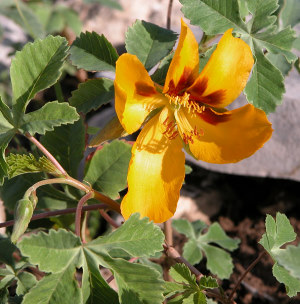Yellow Show
Amoreuxia wrightii A. Gray
Bixaceae (Lipstick Tree Family)
Yellow show is an unusual plant, a perennial herb that grows from a large tuberous root. This is one of those mystery plants that may well have been used as a food source by the native peoples in the Lower Pecos area. Although we have not yet recovered direct evidence from the region, elsewhere in western North America many Indian groups consumed closely related plant species.
Hodgson (2001:91) has summarized the utility of two closely related Sonoran Desert species, A. gonzalezii and A. palmatifida. Wright yellow show is a medium-sized herbaceous plant growing to about 18-inches with 1-1/2-inch palmately-lobed leaves on long petioles (stalks). The flower is larger, measuring about 1-3/4-inch, yellow, with a purple blotch at the base. The stamens are long and tipped with purple. The plants growing in the Comstock/Langtry area are much smaller than those described by Correll and Johnston (1970), but competition from invasive species like bufflegrass is a problem in the area. Yellow show growing in the upper reaches of the Rio Grande arm of Amistad Reservoir appears to bloom semi-annually, possibly connected to the periodicity of rainfall. The tuberous root stock from which the above-ground (flowering) part of the plant emerges would allow long dormant periods. See Cheatham et al. (1995) for additional discussion of the uses and distribution of yellow show in Texas.
Archeological occurrence. Yellow show has not been identified in the collections. It is included here because the plant very likely was utilized; increased awareness of this probability improves the likelihood that it will be discovered by future research.
Food. Ethnographic observations of yellow show center on the Sonoran Desert species, but the form and utility of Wright yellow show conforms closely to its relatives. Every part of this plant is edible or otherwise usable (Hodgson 1989; 1993). Both Edward Palmer and H. S. Gentry have made observations regarding the use of this plant.
Palmer (1878:601) noted that the Indians of Arizona prepared the roots in hot ashes, and that he also tried them himself, finding them tasty but with a slightly bitter aftertaste. Hodgson (2001:91) relates observations of H.S. Gentry, who noted that the yellow show would be an excellent kitchen garden plant, both attractive and edible. The tender green fruits contain seeds that can be eaten raw. The green fruit of Wright yellow show likewise has very flavorful seeds. Even when the fruit matures the seeds are edible, according to Gentry.
Residents of Baja California used yellow show as recently as the mid-20th century. The plant grew during the summer rains and died back in drought. The local people knew where the plants grew and looked for the dried remains of the leaves and stems. The tubers are shaped like a parsnip and are very easy to cook, which means they don't have a lot of secondary metabolites that inhibit ingestion by humans (Aschmann 1959:88).
The Seri ate the flowers of yellow show and the root. The plant was important to the inhabitants of the interior of Tiburon Island. They harvested the root with a digging stick, and ate it raw or cooked on ashes. They dried the root and strung it on cordage to carry it while traveling. The Seri said that the yellow show (saiya) sang a song about itself (Felger and Moser 1985):
We are among the blue flowers,
We are among the blue flowers
We are among them,
The dry lake is all yellow with flowers,
The wind touches us and roars.
References:
Aschmann, Homer
1959 The Central Desert of California: Demography and Ecology. University of California Ibero-Americana Pub. 42, Berkeley, California.
Cheatham, Scooter, Marshall C. Johnson, and Lynn Marshall
1995 The Useful Wild Plants of Texas, the Southeastern and Southwestern United States, the Southern Plains, and Northern Mexico. Useful Wild Plants, Austin, Texas.
Correll, Donovan S. and Marshall C. Johnston
1970 Manual of the Vascular Plants of Texas. Contributions from the Texas Research Foundation, Volume 6. Renner, Texas.
Felger, Richard S. and Mary B. Moser
1985 People of the Desert and Sea. University of Arizona Press, Tucson, Arizona.
Hodgson, Wendy C.
1989 A Tale of Two Saiyas: Conserving Plant Lore and Gene Pools. Agave 3(3):12-14.
1993 Bixaceae: Lipsticktree Family. Journal of the Arizona-Nevada Academy of Science 27(2):188-189.
2001 Food Plants of the Sonoran Desert. University of Arizona Press, Tucson, Arizona.
Palmer, Edward
1878 Plants Used by the Indians of the United States. American Naturalist 12:593-606; 646-655.
![]()

